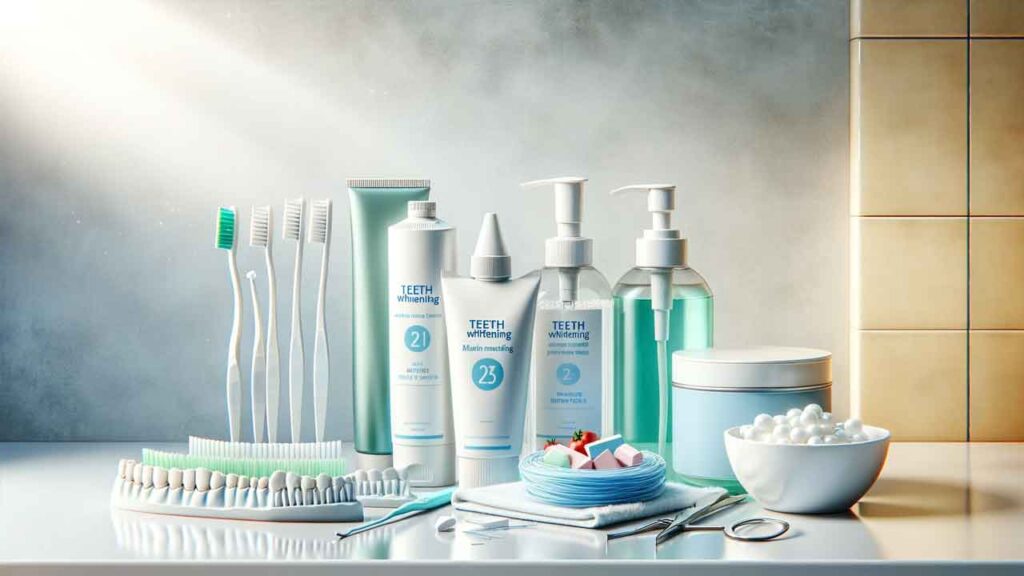In exploring “How to Keep My Teeth White After Whitening?”, it’s crucial to understand the significance of post-whitening dental care. This guide aims to provide comprehensive insights and practical advice on maintaining that bright smile long after the whitening treatment.
Our goal is to equip you with effective strategies and knowledge for sustaining your teeth’s whiteness, ensuring a lasting, confident smile.
How to Keep My Teeth White After Whitening?
Maintaining the whiteness of your teeth after a whitening procedure involves a combination of proper oral hygiene, dietary adjustments, and regular dental care. It’s about adopting habits that prevent re-staining while nurturing your dental health.
Mastering Post-Whitening Dental Care

Understanding Immediate Post-Whitening Care
Right after teeth whitening, your teeth are more susceptible to re-staining. It’s advisable to avoid highly pigmented foods and drinks like coffee, red wine, and berries for at least 48 hours. This period is critical in determining how long your whitening results will last.
Daily Oral Hygiene Post-Whitening
Your daily oral hygiene routine plays a pivotal role in maintaining the effects of teeth whitening. Brushing twice a day, flossing regularly, and using an alcohol-free mouthwash can help keep stains at bay. It’s also beneficial to rinse your mouth after consuming stain-causing foods or drinks.
Selecting the Right Toothpaste and Brushes
Choosing the right toothpaste and toothbrush is essential for post-whitening care. A toothpaste designed for whitened teeth can help remove surface stains without being too abrasive. Soft-bristled toothbrushes are recommended to prevent enamel erosion.
Comparison of Suitable Toothpastes Post-Whitening
| Toothpaste Type | Benefits | Considerations |
| Whitening Toothpaste | Helps remove surface stains | Should not be overly abrasive |
| Fluoride Toothpaste | Strengthens tooth enamel, prevents decay | Ideal for daily use |
| Sensitivity Toothpaste | Reduces post-whitening sensitivity | Beneficial for those with tender gums |
| Natural Toothpaste | Free from harsh chemicals, eco-friendly | May not be as effective in removing stains |
Dietary Considerations for Lasting Whiteness
“How to Keep My Teeth White After Whitening?” Through Diet
Maintaining the whiteness of your teeth after a whitening treatment significantly depends on your dietary choices. What you eat and drink can either preserve or compromise your whitening results.
Identifying Foods and Beverages to Avoid
Certain foods and beverages are notorious for staining teeth. Coffee, red wine, tea, dark sodas, and deeply colored fruits like blueberries should be consumed in moderation. Acidic foods and drinks, which can erode enamel and expose the yellowish dentin beneath, also need to be limited.
Nutritional Choices to Maintain Whitening Results
Incorporate teeth-friendly foods into your diet, such as dairy products rich in calcium, crunchy fruits and vegetables like apples and carrots, and water, which helps rinse away food particles and staining agents.
Foods to Avoid vs. Foods to Consume Post-Whitening
| Foods to Avoid | Foods to Consume |
| Coffee, tea, red wine | Water, milk |
| Berries, soy sauce | Cheese, yogurt |
| Acidic fruits (lemons) | Crunchy fruits and vegetables |
| Dark sodas | Nuts and seeds |
Professional Dental Follow-Up and Care
The Necessity of Regular Dental Check-Ups
Regular dental check-ups are crucial in maintaining the whiteness of your teeth post-whitening. Your dentist can monitor your oral health and ensure that your whitening results are sustained over time.
Professional Cleaning: Its Role in Maintaining Whiteness
Professional cleanings remove plaque and tartar that can cause discoloration. These cleanings also provide an opportunity for your dentist to polish your teeth, further enhancing their whiteness.
Customized Professional Advice for Whitening Maintenance
Each individual’s teeth respond differently to whitening treatments. Customized advice from your dentist, based on your oral health and whitening history, can guide you in maintaining your results effectively.
Schedule for Dental Visits Post-Whitening
| Timeframe | Type of Visit |
| Every 6 months | Routine check-up and cleaning |
| Annually or as recommended | Evaluation of whitening needs |
| As needed | Consultations for sensitivity or issues |
Lifestyle Adjustments for Prolonged Whiteness
Impact of Smoking and Drinking on Teeth Color
Smoking and excessive alcohol consumption can lead to significant teeth discoloration. Quitting smoking and moderating alcohol intake can vastly improve the longevity of your teeth whitening.
Effective Lifestyle Modifications Post-Whitening
Lifestyle changes like reducing the intake of staining foods and drinks, increasing water consumption, and quitting smoking are essential for maintaining the whiteness of your teeth.
Understanding the Balance Between Habits and Oral Hygiene
Balancing your daily habits with proper oral hygiene is key. Brushing and flossing after consuming stain-causing foods and drinks can help minimize their impact on your teeth’s color.
Navigating At-Home Whitening Products Safely
Guidelines for Using Whitening Strips and Kits
Using at-home whitening strips and kits can be an effective way to maintain your smile’s brightness. It’s essential to follow the product instructions meticulously – this includes the amount of product to use, the duration of each application, and the total length of the treatment period.
Safety and Efficacy of Home Whitening Methods
The safety and efficacy of at-home whitening depend largely on following the guidelines and understanding the product’s limitations. Overuse or incorrect application can lead to tooth sensitivity or gum irritation.
Recognizing the Limitations of At-Home Products
At-home whitening products are typically less potent than professional treatments. They are best used for maintaining whiteness rather than making significant color changes.
Safe Usage Guidelines for At-Home Whitening Products
| Product Type | Usage Frequency | Key Safety Tips |
| Whitening Strips | As directed on the package | Avoid overlapping onto gums |
| Whitening Gels | Typically, once every 6 months | Use the provided trays to avoid over-application |
| LED Whitening Kits | As recommended by the manufacturer | Do not use with sensitive teeth without consulting a dentist |
Essential Oral Hygiene Practices for Whitening Longevity
Advanced Brushing and Flossing Techniques
Effective brushing and flossing are crucial for maintaining whitening results. Use a soft-bristled brush to avoid abrasion and floss gently to remove particles and plaque that can lead to staining.
Choosing Mouthwash and Dental Floss for Whitened Teeth
Select alcohol-free mouthwashes as they are less likely to cause dryness and irritation. Choose dental floss that is gentle on the gums but effective in removing debris.
Consistency in Oral Care Routine
Consistency is key in oral hygiene. Brushing twice a day, flossing daily, and regular use of mouthwash can greatly extend the longevity of your teeth’s whiteness.
Oral Hygiene Practices and Their Impact on Teeth Whitening
| Practice | Frequency | Impact on Whitening |
| Brushing | Twice daily | Removes surface stains, prevents plaque build-up |
| Flossing | Once daily | Reduces risk of staining between teeth |
| Mouthwash | Once or twice daily | Helps in removing food particles and bacteria |
Exploring Natural Methods for Whiteness Maintenance
Effectiveness of Natural Whitening Remedies
Natural remedies like baking soda, apple cider vinegar, and oil pulling can be used to maintain teeth whiteness. However, their effectiveness is generally less pronounced than commercial whitening products.
Homemade Solutions and Their Role in Teeth Care
Homemade solutions can be a safer alternative for those with sensitive teeth. However, they should be used cautiously as some natural substances can be abrasive or acidic.
Aligning Natural Methods with Dental Recommendations
Always align natural whitening methods with dental recommendations to ensure they are safe for your specific oral health needs.
The Science Behind Post-Whitening Teeth Staining
Mechanism of Teeth Staining After Whitening
Teeth can get stained post-whitening due to the porous nature of enamel, especially immediately after a whitening treatment. Staining agents from food and drink can easily penetrate and discolor the teeth.
Strategies for Enamel Protection and Stain Prevention
To protect enamel and prevent staining, avoid highly pigmented and acidic foods immediately after whitening treatments. Use a straw for beverages to minimize contact with teeth.
Dietary and Lifestyle Factors Affecting Teeth Color
Diet and lifestyle greatly impact the color of your teeth. A diet high in fruits, vegetables, and water will help maintain your teeth’s whiteness, while smoking and high consumption of staining beverages can reverse the effects of whitening.
FAQ: Maintaining White Teeth After Whitening
“How Can I Extend the Life of My Teeth Whitening?”
To extend the life of your teeth whitening, maintain a strict oral hygiene routine, avoid foods and drinks that cause staining, and consider using touch-up treatments as recommended by your dentist. Regular dental check-ups and cleanings also play a vital role.
“What Foods Should I Avoid to Maintain White Teeth?”
Avoid foods and drinks with strong colorants such as coffee, tea, red wine, dark berries, and sauces like soy or tomato sauce. Acidic foods that can erode enamel, like citrus fruits and vinegary dressings, should also be consumed in moderation.
“How Often Should I Visit the Dentist After Teeth Whitening?”
Post-whitening, it’s advisable to visit the dentist for regular check-ups every six months. If you experience any issues like increased sensitivity or uneven coloring, schedule a visit sooner.
“Are There Any Natural Methods to Maintain Teeth Whiteness?”
Yes, natural methods such as oil pulling with coconut oil, brushing with baking soda, and rinsing with diluted apple cider vinegar can help maintain teeth whiteness. However, they should be used cautiously and not as substitutes for regular dental care.
“What Are the Best Oral Hygiene Practices After Teeth Whitening?”
The best practices include brushing twice daily with fluoride toothpaste, flossing once a day, and using an alcohol-free mouthwash. It’s also beneficial to brush or rinse your mouth after consuming stain-causing foods and drinks.
“How Can Smoking Affect My Whitened Teeth?”
Smoking can significantly affect your whitened teeth, leading to yellowing and staining. The tar and nicotine in cigarettes are major culprits for discoloration, making it challenging to maintain whitening results.
“Is Using Whitening Toothpaste Daily Safe Post-Whitening?”
Using whitening toothpaste daily is generally safe post-whitening. However, it’s important to choose a toothpaste that is not too abrasive to avoid damaging the enamel. Look for toothpaste specifically designed for post-whitening care.
In conclusion, “How to Keep My Teeth White After Whitening?” involves a combination of careful dietary choices, regular and effective oral hygiene, and professional dental care. Consistent care and adherence to recommended practices are key to sustaining the effects of teeth whitening.
It’s also important to stay informed and consult with dental professionals for personalized advice, ensuring that your approach to maintaining white teeth is both effective and safe for your overall dental health. By adopting these informed and sustainable teeth whitening practices, you can enjoy a brighter smile for longer.
